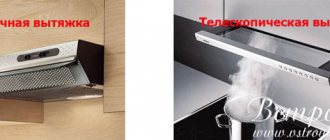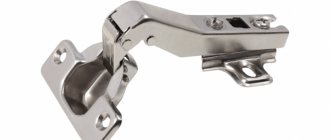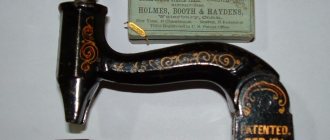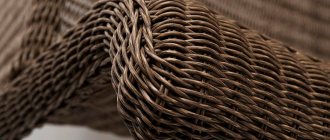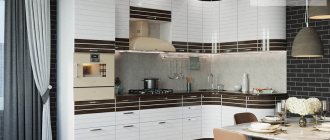Regardless of whether the kitchen is equipped with a gas or electric stove, the hood is not a tribute to fashion, but an everyday necessity. During the cooking process, the air in the room becomes polluted with soot, particles of dust and grease, and unpleasant odors appear. A powerful hood with a high-quality filter can eliminate them quickly and effectively. In this article we will tell you: which kitchen hood to choose so that it copes well with its direct responsibilities and lasts as long as possible, we will get acquainted with the advice of professionals, and we will learn how to independently install an electrical appliance and its maintenance.
Types of kitchen hoods
On the Russian market, hoods are presented in a wide range and at an affordable price. Among them:
- built-in;
- island;
- hanging (horizontal and vertical);
- dome;
- and telescopic.
Let's look at each type in more detail.
Built-in
Today, such hoods are most in demand among buyers. This is due to the following advantages:
- they are great for small spaces;
- You can place various kitchen utensils above the device and thereby make the most of your workspace;
- The design is hidden in the closet, thanks to which the style of the interior solution is preserved.
The only drawback is the additional material costs associated with arranging the box for the structure. Built-in hoods are more expensive than other modern models.
Island
Electrical appliances are installed strictly above the hob. This is an important condition for their proper operation. In this case, unpleasant odors and soot are removed quickly and as efficiently as possible.
The advantages of this type of hoods include:
- the ability to choose a model with any size - since the structure is attached to the ceiling, the main thing is that there is enough free space;
- a wide range - from standard rectangular to modern dome devices.
Hanging horizontal
Reviews on the Internet indicate that most users prefer a classic hanging hood, which can naturally fit into any modern kitchen interior.
The housing is attached directly above the stove or hob under the cabinet. The electrical device is easy to install and has an affordable price. However, the horizontal hood has low productivity due to the fact that it is not directly connected to the shaft - polluted air is forced through a filter, cleaned and returned to the room.
This is an ideal solution for small kitchens with an area of no more than seven square meters. To give the hanging model an attractive appearance, a small kitchen cabinet is installed above it - the resulting structure from the outside looks like an expensive built-in electrical appliance.
Vertical hanging models
In general, they are no different from the first ones, the only nuance is the installation method. Such hoods are installed strictly vertically, which is why they look like a stylish, elite accessory. They can be flow-through or circulating.
Dome
They differ from previous models in practicality, rich functionality, and ease of use. From the outside they look like the roof of a house with a chimney. They can have a rectangular or trapezoidal shape.
Made from steel, many modern models are decorated with colored glass inserts. Dome hoods are attached to the kitchen wall; self-installation does not cause any difficulties.
This type of electrical appliance has high productivity. Among the wide range, it is always possible to choose the most suitable option for the size, style of the kitchen and the allocated budget. Hoods can be inclined or horizontal.
Deciding: diversion or recycling
For a long time there was an opinion: diversion is definitely better than recycling. Modern hoods refute this assumption. By installing not only grease filters, but also carbon filters, you can ensure the quality of air purification is no worse than its constant renewal.
Setting up an outflow is not always possible and not always advisable. If there is no draft in the ventilation, blowing into the pipe with a fan is most often useless - there will be no normal outflow. Any normal teenager who has read the adventure novels of Jules Verne knows how to test cravings. We bring the flame of a candle, lighter or match to the ventilation grille. If the tongue deviates towards the pipe, there is traction. No means no.
Lack of traction does not indicate a clogged channel. Most often, ventilation does not work due to design miscalculations or unauthorized redevelopment of apartments, when a careless neighbor turns off the ventilation duct.
The location of the stove in relation to the ventilation hole also plays a role. Carrying several meters of corrugated or profiled pipe is a dubious task. It’s not enough to lay it, attach it and seal it. We still need to somehow disguise or decorate this pipe so that it doesn’t look like the forgotten socks of a migrant worker in a 7,000 euro Jacuzzi against the backdrop of a European-quality kitchen renovation.
If there is a cabinet hanging above the stove, intended for installing a hood in it, then by extending the air duct, we will occupy the entire height of the cabinet. Or they could use half the volume for business.
Telescopic
The devices are very convenient to use in a small space and in a spacious kitchen; they are capable of purifying the air at a maximum speed of a thousand cubic meters per hour.
The domestic household appliances market offers 1- and 2-motor telescopic hoods equipped with a turbine, which are recognized as the most efficient to use. But when choosing, you should not pay much attention to power, because the product data sheet indicates the dimensions of the ventilated rooms and the recommended productivity.
The advantages of this type of electrical appliances include:
- A retractable panel that creates a large area for air suction, which is why particles of dust, grease and unpleasant odors will not leave the kitchen.
- Compactness, small dimensions of the structure, which allows you to easily place it in a furniture set.
- High productivity.
- A thin retractable bar that can perfectly complement any kitchen interior.
- Simplicity, clarity of design, absence of unnecessary elements.
- Possibility of 2-mode operation.
- Additional LED lighting, which will appeal to lovers of evening gatherings.
- Simultaneous installation of a carbon and grease filter.
- Possibility of maximum efficient use of work space, stylish, modern appearance and long service life.
What filters can hoods be equipped with?
The hood filtration system may contain coarse and fine cleaning, or only one of these options.
Grease filter
Coarse cleaning element. Consists of stainless steel threads woven together. They are enclosed in rectangular frame panels that can be removed for cleaning by simply pressing a latch. The panels are designed to trap grease particles rising with the air so that they do not fall on the engine and fan blades. Periodically, the grease trap grate must be removed and washed, otherwise it will become overgrown with grease and may even catch fire.
Hood grease filter.
Carbon filter
Fine cleaning element. Mandatory for models with recirculation. Activated carbon granules absorb unpleasant odors, purifying the air flow. Over the course of its service, it strains the molecules of other substances and becomes ineffective, so it needs to be replaced every 2-4 months, depending on the frequency of use of the hood.
Hood carbon filter.
Main characteristics, nuances of choosing a model
What parameters should you use to select a kitchen hood? Note that in addition to the design features of manufacturing, each modern model has a unique list of functional characteristics.
Therefore, before making your purchase, we strongly recommend that you get acquainted with all the models and understand which one is ideal for your kitchen and how much work it can perform.
Air purification methods
There are three types of kitchen hoods:
- recirculation - passing through the filter, polluted air is cleaned and then returned to the room;
- exhaust - dirty air exits into the ventilation shaft;
- combined - capable of working in 2 modes simultaneously.
Devices without an air duct are equipped with two filters; although they prevent the formation of soot on the walls, they do not neutralize odors well enough. Their main advantage is the presence of a compact design that does not require connection to a stationary ventilation system.
Models with a steel or carbon filter demonstrate the greatest efficiency when used. The first one destroys soot and fatty particles, the second one destroys foreign odors.
Recirculating electrical appliances have a rather complex design, which affects the price. In addition, you need to remember: cleaning filters need to be cleaned regularly and changed from time to time. This must be done once every twelve months - the service life depends on the power, size of the hob, and its frequency of use.
Tap-off models are more difficult to install, but they are more efficient in operation and are characterized by high power. To install such a cleaning system, you will need to purchase an additional air duct.
Note that changes and turns in it negatively affect the productivity of the entire exhaust structure, because an obstacle is formed in the path of the air flow. Despite this, flow-type hoods still have higher productivity than recirculation hoods.
They are equipped with a steel filter that does not require replacement, only periodic cleaning. As for aesthetics, a corrugated pipe can disrupt the style and interior design of the kitchen space, so it is often placed in a closet.
We also note that many modern models are additionally equipped with a function to automatically turn off the device when food begins to burn on the stove. The presence of a special sensor ensures control of vapor density over the working area.
In addition, several years ago, devices with an “aerodynamic effect” appeared on the domestic household appliances market - sucking air around the entire perimeter of the structure.
They have another fan built into them, which generates a strong air flow along the edges of the device, due to which the efficiency of removing unpleasant odors above the hob increases significantly.
Operating power
An important criterion for choosing the right kitchen hood is its productivity - it must correspond to the power of a gas or electric stove and the area of the room. The data sheet indicates the power value of the device, provided it is placed at the height above the desktop recommended by the manufacturer.
Its standard size is 60–80 cm. When installed below 55 centimeters, the cooking process becomes more complicated and the food will overheat. When the installation height is more than 86 cm, you will have to buy a hood with higher productivity.
The ideal solution is to choose a model that has a function for smoothly adjusting operating power. When the device’s electric motor operates at medium speeds, its service life will increase significantly.
Noise level
It is clear that a kitchen hood cannot operate absolutely silently, because its design contains an electric fan with blades. However, when the device is capable of operating at several different speeds, intermediate values reduce the noise level. Noise in the range of 35–45 dB is considered comfortable for the human ear.
If you prefer not to hear it at all, then you should pay attention to models that are installed on the principle of split systems - a unit with an electric motor is placed outside, the second is placed in the kitchen. Such hoods are quite expensive, their range is small, and there are no technical capabilities for installation in standard apartments. They become a wonderful solution for country cottages.
Adjusting the noise of the hood
Let’s be clear right away: nothing can be done about the noise of the electric motor. If it initially roars like a Su-25 turbine, you’ll have to put up with it. But it’s not just the engine that affects acoustic comfort. The design of the hood itself can amplify the sound, like a bell.
Obstacles at the entrance - fine mesh grating or mesh can cause whistling. Just like poor filter design. And if the installer or the owner himself saved time and money and used a metal corrugation for the outlet, rest assured, it will add noise. Any obstacle in the path of air is fraught with unnecessary noise, and in the corrugation there are 20-25 of them for every meter of the structure.
Conclusion: carefully read the instructions and do not take a hood with a noise level above 55 dB - this volume level corresponds, for example, to a typewriter or people talking in a raised voice, when the interlocutors are at least 5 meters apart.
We do not make a corrugated bend. We reduce connections, turns and elbows in the duct to a minimum. We follow the principle: the larger the cross-section of the pipe, the quieter the air in it.
Other important nuances of choice
When choosing a hood for the kitchen, you should be guided by additional criteria:
- Design - the best device will be the one that can naturally fit into the existing style solution and will not become a third-party item. Models made in a modern high-tech style are distinguished by their original appearance, but their functional characteristics are inferior to hoods of standard shape and configuration. Ellipse-shaped devices with compact glass panels also look unusual. Dome models are great for kitchen interiors decorated in Provence or country style.
- If you want the hood to stand out in the room, you should definitely give preference to the built-in option. In this case, most of its structure and the corrugated pipe itself will be hidden behind the cabinet facades.
- The modern industrial urban loft style allows the use of rough structures made of metal and wood, pipes, concrete and brick walls, countertops made of artificial stone, etc. in the style decision.
- Dimensions - the ideal solution is to buy a device for the kitchen with dimensions no smaller than a stove or built-in surface for cooking. If it is smaller, the power declared by the manufacturer to effectively remove extraneous odors will not be enough. Built-in models have standard width dimensions - 55 or 65 centimeters. Sometimes you can find devices with a width of thirty centimeters that are suitable for a modular headset.
- The latter are based on activated carbon, which traps vapor impurities, odors, and harmful gases. They are installed in recirculation type hoods, in which air from the room is not exhausted to the outside.
Reusable grease-absorbing filters are cleaned once thirty days using ordinary household products. Less common are disposable filters made from padding polyester, paper, and acrylic, installed in budget models. They are changed as they become dirty no more than once every two months.
There is no clear answer to the question of which cleaning filter for a kitchen hood is better - everything will depend on the frequency of use of the device and the degree of air pollution in the room. One thing we can say for sure is that it is better to refrain from purchasing electrical appliances with non-woven filters, which are less practical and short-lived in use.
Types of designs
The first thing you should understand is what types of kitchen hoods there are in terms of design and body format. Different types of kitchen hoods differ in installation method, size, power and design. The hood above the stove should not look like something foreign, but fit into the overall style of the room - this also complicates the choice.
Block type suspended hoods
The most popular and affordable devices belong to this type. They do not take up too much space, and choosing a hood that fits into the interior is not difficult.
The block-type device is mounted directly above the stove, under a wall cabinet or openly, for example, in the space between two cabinets. This kitchen hood works on the principle of air mass recirculation. It sucks in polluted air, filters it and returns it back through the air duct.
The key differences between such hoods are the type of filter and the number of motors (1 or 2). Options with two motors are more efficient, but they are often noisier during operation.
The main elements of such a hood are a motor and a filtration mechanism. Most modern hanging hoods also have a grease trap, built-in lighting and the ability to regulate the speed of the device.
In recent years, cylindrical devices have appeared on the market. These unusual-looking appliances, which lack such a traditional detail as an “umbrella” - an extension at the bottom of the body - take up less space in the kitchen and will appeal to those who do not like the sharp outlines of classically shaped hoods.
To summarize, we can note the following advantages and disadvantages of this option.
Pros:
- Easy to install - you just need to choose the installation location wisely. Nothing should interfere with access to the air duct and electrical network. The only tools you will need are fasteners and an electric drill.
- Affordable price – from 3000 rubles.
- Low noise level during operation - about 45 dB with one motor.
- A wide range of models and the ability to choose a device whose design will suit your kitchen.
Minuses:
- They cope poorly with air filtration in large areas. First of all, this applies to low-power budget hoods.
- Most models require regular filter replacement and device cleaning.
Important! The hood package must include an air duct and a set of fasteners necessary for installation.
Built-in hoods
If you need an appliance that you don’t notice when you enter the kitchen, then the best option is a built-in hood. Most of these hoods, completely hidden by a hanging cabinet, are additionally equipped with a telescopic panel that can increase productivity. In other options, the entire work surface is pulled out, out of sight when it is not needed.
Important! If your choice is a built-in kitchen hood, it is important to pay special attention to the measurements of the kitchen furniture. To avoid mistakes, it is better to consult a specialist in advance and find out how much space a specific device requires.
There is another option for built-in hoods - countertop-mounted. They are suitable for small-sized kitchens, but you can rarely find them on sale. The reasons are low power at a fairly high price.
Pros:
- Invisibility, and therefore the ability to fit it into any design.
- Variety of model range. Such hoods come in a variety of styles, differ in materials and control methods.
- Traditional, without a bunch of additional functions, but the internal one will cost a little more than 2000 rubles.
Minuses:
- Installation of such a device is more difficult than a conventional one.
- Clear measurements of the kitchen unit are required.
- Some types of built-in hoods are significantly more expensive than conventional ones.
Dome hoods
The option with the highest power. The fans in these devices are larger than in conventional ones. A suitable type of device for large, including restaurant kitchens. Unfortunately, such a device has appropriate dimensions; hiding it will be problematic. It is difficult to confuse it with something else - most models are distinguished by a recognizable, trapezoidal or hemispherical shape.
The operating principle is based on either connection to a central ventilation system or recirculation. Such exhaust equipment is most often equipped with several filters at once.
Dome hoods are presented in 3 formats, from which you should choose based on the installation location of the stove.
- Fireplace stoves are suitable if the kitchen uses a gas or electric stove placed near the wall. It is possible to hide such a device in a kitchen cabinet.
- Island (“umbrellas”) are the choice of the owners of kitchen islands, popular in the West and recently introduced to Russia and the CIS - working and dining areas located in the center of the kitchen.
- Corner units are a good way to save space in the kitchen. If the stove is located in the corner, you need to take a closer look at these models.
The latest types of hoods have a lot of nuances in operation and installation, so they are worth considering separately. As for the general pros and cons of this format, they are as follows:
Pros:
- Powerful and efficient – unpleasant odors will leave even the farthest corners of the kitchen.
- You can choose a model for any kitchen layout. Classic design or minimalism, soft, curved lines or strict straight lines - you can find any option. It will look most advantageous in the kitchen interior.
Minuses:
- Bulky look.
- Often, additional difficulties arise when connecting to the ventilation system.
- Price – at least 6,000 rubles for the simplest device.
Island and T-shaped hoods
Both of these options will be the best choice for owners of large kitchens with a kitchen island.
The difference between island-type hoods is that they are mounted on the ceiling; T-shaped hoods can also be mounted on the wall. Most hoods of this type are recirculating, due to the installation features. However, this does not affect their effectiveness - such devices are among the most powerful.
Many ceiling hoods can be adjusted in height, bringing them closer to or away from the surface of the slab. For restaurant kitchens, a big advantage of island hoods is the ability to mount several appliances in a row.
Pros:
- High power and efficiency of the hood.
- Variety of designs.
Minuses:
- They are louder than other types of kitchen hoods.
- Expensive option.
- Not suitable for small kitchens.
Corner hoods
Such devices are available in dome or T-shaped versions and are well suited for those cases when you want to save space in the kitchen. In such devices it is easier to hide the air duct, which adds points to them, helping to visually “clear” the space.
The operating scheme can be either standard or recirculation. It is among these hoods that most often there are devices that use side outlets.
Pros:
- Additional space is freed up in the kitchen, often empty corners are used.
- Installation does not require special skills.
- Small sizes do not prevent corner devices from effectively purifying the air.
Minuses:
- Prices for high-quality corner hoods from trusted manufacturers start from 10,000 rubles.
- It will not work if the stove is already installed far from the corner, and there are no plans to change its position.
Vertical hoods (oblique)
Relatively new format. This hood, with a working surface located at an angle, is ergonomic and does not take up much space in the kitchen. A flat one with a modern design will look good in a minimalist or high-tech interior.
The devices are most often touch-sensitive and made of tempered glass. This model will also be distinguished from the usual one by its automation of operation - most vertical devices are equipped with additional functions, such as monitoring the filter status, several lighting options, and an automatic on and off system.
These closed-type devices are the quietest, with quite a lot of power. Unfortunately, such a number of advantages could not but affect the price. An inclined hood above the stove is one of the most expensive options.
Pros:
- Nice design.
- Quiet operation.
- Power of the “filling”.
Minuses:
- High price - even the simplest option will cost no less than 4000 - 5000 rubles.
Now that it has become clearer which of the presented hoods is suitable for your kitchen, you can move on to other parameters.
Types of control
Modern kitchen electrical appliances are controlled using:
- sensors - the functional mode is selected by lightly touching the required sector with your fingers, after which the LED lamp lights up and the hood executes one or another command;
- standard and familiar buttons , each of which corresponds to a specific operating mode;
- mechanical slider - moving along the surface, it provides the required rotation speed of the fan blades.
Types of hoods by control method
Another criterion for classifying household hoods is the way they are controlled. Main types 3:
Keypad
Usually there are buttons to turn on the device, turn on the backlight and adjust the speed. This hood control is most often found in budget models.
Slider control
In the slider or, in other words, slider version, the device is controlled through manipulations with “sliders” moved along a special scale.
Touchpad
The most modern and intuitive type of control. All actions with the hood are carried out through the touch panel or the remote control included with some models.
In addition to simplicity, the big advantage of touch controls is that they don't make cleaning difficult - the owner doesn't have to fiddle with wiping the buttons and the space between them, which can add to the hassle.
Now let's see what kind of kitchen hoods there are, if we divide them according to the material from which they are made.
Kitchen hood material
The daily care and cost of electrical appliances is determined not only by the functional characteristics, but also by the material of manufacture. Kitchen hoods are made of aluminum, steel, glass, plastic or enameled.
The most popular and inexpensive among Russian buyers are models made of aluminum alloy. They have a fairly attractive appearance and do not require special care.
More stylish and aesthetically pleasing are stainless steel devices that harmonize perfectly with the same hob and sink. They usually have light shades - beige, white or gray and a width of 55 to 65 cm.
Important! The ratio of the dimensions of a gas or electric stove and the kitchen hood itself should be as follows: the device is mounted above a built-in surface of smaller width, not vice versa.
As a result, it is possible to ensure maximum efficiency in work. But such models have a fairly high price, and caring for them is not easy, because any traces and dirt are clearly visible on the mirror surface.
Tempered glass devices are the most expensive option and require time-consuming day-to-day maintenance. However, from the outside they look incredibly elegant, stylish and expensive; they are most often installed in studio kitchens with an open plan. They allow you to favorably emphasize the individual style of the room and differentiate the working and dining areas.
Which hood is better for the kitchen and photos of coal and fat appliances
I would like to pay special attention to which coal hoods are best to pay attention to. Their main task is not only to fight fat and smoke, but also to clean the air as much as possible from excess odors; as a rule, they are placed after fatty ones. If you choose which hood cleans better: coal or grease, then the first option is certainly the leader, however, it is not without its drawbacks. When choosing an option with a carbon filter, you should be prepared for additional costs, because it will have to be changed quite often. One of the most optimal options for such a device is TEKA TL1 62 BK, because it is compact, quite powerful, but at the same time silent, has an incandescent lamp and an excellent filter system. The only compelling argument to refuse to purchase this miracle of technology may be its price.
Depending on the design of the room, variations in the placement of the device are possible. Fortunately, now there are plenty of opportunities to realize your ideas.
Before such a responsible purchase, first of all, it is worth understanding the features of the models and how they differ from each other. When choosing which hood is best to choose for the kitchen, you need to take into account that they come in different types of mounting:
- hanging;
- dome;
- built-in
All these types have their positive and negative sides. And we are not talking about resistance to high temperatures, because this is already the case by default.
Below are various photos of kitchen hoods, and which one is better in an aesthetic and visual sense, the consumer will choose:
There are completely different kitchen hoods presented here, and it is better to decide which hood you should choose after inquiring about all the issues regarding this matter.
Self-installation of a kitchen hood
Professional advice will tell you how to properly install an electrical appliance above the hob so that it functions efficiently and for as long as possible.
So, special attention should be paid primarily to the height of the device relative to the stove. When it is fixed high, you should not expect fruitful work, and this means one thing - all the fumes and foreign odors from cooking will remain indoors. Otherwise, the hood will complicate the cooking process.
The ideal solution is to maintain a height above the hob of 75–80 centimeters.
Another important nuance that will affect the productivity of the device is its distance from the air exhaust shaft. The closer it is, the fewer pieces of corrugated pipe and connecting elbows will be required, this will increase the exhaust force and reduce noise.
Having ensured that the hood is securely connected to the shaft inlet, you need to take care of covering it. You will need a valve and a grille for this.
Advice! The diameter of the air duct should be larger than the exhaust hole of the electric hood, which will significantly reduce the load on the electric motor and allow the work to be done more efficiently and with a low noise level.
What equipment dimensions allow you to optimally remove odors?
When choosing a design, be sure to pay attention to the correspondence between the dimensions of the stove and the hood. The undersized dimensions of the latter can greatly hinder the performance of the exhaust system and will require increased fan power.
This issue is usually judged by the width of the hood. To work effectively, it should protrude slightly beyond the dimensions of the controlled slab or have equal outlines.
Her most time-consuming tasks are:
- collect fat that is formed during frying in a frying pan;
- absorb steam released when cooking food.
Fat and steam that are not completely removed will settle on the kitchen unit during the cooking process, shorten its service life, and disrupt the overall design. This is especially true for gas stoves, which additionally emit gas combustion products that are far from safe.
By choosing the ratio between the width of kitchen equipment, we ensure optimal, effective or poor-quality removal of vapors, grease and odors from the room.
Compliance with the dimensions of the stove and hood ensures high-quality operation of all equipment and a long service life of kitchen furniture.
Strengthening the hood over a kitchen gas stove
The complexity of installation work directly depends on the type and size of the device. Thus, flat-shaped models are attached to the bottom of a hanging cabinet or directly to the wall surface with metal hooks.
Models with a corner strip are placed inside the cabinet; a through hole of the required diameter for a corrugated pipe is made in advance. Dome hoods are mounted on the wall surface.
After the filter device is installed, an air duct is connected to the outlet and secured with special hooks. It can also be a polyvinyl chloride pipe with a smooth wall surface - this is the cheapest option.
After installation, it will require regular cleaning of fat deposits, soot, and dirt. A steel box is more comfortable to use, but its installation will require significant material expenditure. The video will tell you more about how to properly install a hood over a gas stove with your own hands:
How to install a hood on an uneven wall
How to choose a hood for the kitchen, recommendations from experts
Even if the ventilation in your home is excellent, you won’t be able to cook without a hood. When you stew or fry something, a variety of aromas will definitely appear in the room. Before deciding which device is best, check out all the available options. That is, the model of the exhaust device should look perfect in your interior. And it’s not a fact that the appliance you saw at your friend’s and fell in love with will look good in your kitchen.
In order for you to understand exactly how to choose a hood for your kitchen, we offer advice from professionals. They know exactly how to do it correctly and what to pay attention to.
- When choosing an exhaust device, be sure to pay attention to its appearance, whether you like it, and whether it fits into the interior.
- Be sure to measure the place where it will be located in order to choose the correct size of the device.
- Look at the form, whether it will be convenient for you to use, and whether it looks somehow ridiculous.
- It is also very important to pay attention to the power of the device. It should effectively remove all odors. Therefore, the larger the room, the more power the unit should have.
- And lastly, look at the operating principle of the device. It's a matter of taste. We will tell you a little further about what principles of their work exist.
Which company to choose
Let’s make a rating of global manufacturers of electrical cleaning appliances that offer the average buyer budget and luxury models for every taste and cost.
Most modern experts advise giving preference to famous brands: Hansa, Bosch, Samsung, Siemens, Elikor, Gorenie or Kronasteel, which combine excellent factory quality, aesthetic and original appearance, and a reasonable price.
Kitchen appliances from (Germany) compare favorably with competitors in their brevity and versatility. They are practically silent in operation; reliable materials and modern production technologies provide them with excellent productivity and a long service life.
As for the body, its ergonomic shape is carefully thought out; if necessary, it can be easily integrated into a kitchen set and does not violate the integrity of the interior space. The cost of Siemens hoods starts from thirteen thousand rubles.
Krona devices are no less popular among buyers. Today, the world-famous company produces seven collections of air purification equipment. The entire model line is characterized by excellent build quality.
Kitchen electrical appliances are equipped with high-quality, reliable, low-noise motors that provide excellent productivity throughout their entire service life. However, you have to pay for quality - the cost of Krona hoods starts from six thousand rubles.
Hansa kitchen equipment is very compact and easy to use. You can buy it from four thousand rubles.
Buyers who are not used to saving on functionality and quality will definitely like kitchen appliances from the famous German manufacturer. In operation, the equipment demonstrates excellent functional performance, and the modern design meets the latest trends in world fashion. As for the cost, you will have to pay up to thirty thousand rubles for an electrical appliance.
Among the Russian manufacturers of household appliances for the kitchen, it is worth highlighting the Elikor company. On the domestic market, hoods of different sizes, designs and configurations are presented in a wide range. The buyer is offered models in ten colors: Empire, beige, silver, gray, bronze, black, etc. You can purchase Elikor equipment at prices ranging from four to twenty thousand rubles.
For several years now, products have been associated with durability, reliability and high functionality. Modern hoods delight domestic buyers with impeccable performance, high safety and rich functionality. Models with standard equipment will cost you seven thousand rubles.
In the ranking of the best manufacturers of modern kitchen appliances, Gorenje occupies not the last place. The production uses environmentally friendly materials that are completely safe for human health, innovative technologies, and the latest achievements in science.
Thanks to this, kitchen hoods are high-tech, capable of providing clean, fresh air in the kitchen in the most difficult conditions. In terms of price, the Gorenye hood will cost you 4–6 thousand rubles. The following video will introduce you to the rating of the best kitchen hoods of 2022:
The best kitchen hoods of 2022!!!
Popular manufacturing brands
When choosing a range hood model for your kitchen, it is better to give preference to products from well-known brands that are famous for their high quality equipment.
Hoods produced under the Bosch, Siemens and Krona brands are very popular. These brands offer flagship device models at mid-range prices.
You can also note such brands as Gorenje and Hansa. There are many positive reviews about them from customers.
Among Russian-made hoods, the popular brand is Elikor, famous for its excellent build quality and stable operation.
Price policy
In general, kitchen hoods presented on the domestic market can be divided into categories:
- Lower price segment - models are made of high-strength, shockproof polyvinyl chloride and have the smallest dimensions - 55 by 65 centimeters. They are equipped with push-button control, productivity does not exceed 500 cubic meters. meters per hour. The work area is illuminated with incandescent lamps.
- Middle segment - devices are made of stainless steel, aluminum alloy or tempered glass. To illuminate the hob, they are equipped with halogen lamps; the functional mode is set using touch control. Productivity does not exceed 700 cubic meters. meters per hour.
- The premium class includes electrical appliances with excellent technical characteristics, original and modern design. Control is carried out by remote control, and productivity reaches 1350 cubic meters. meters per hour.
Rating of the TOP 5 best models
| Place | Name | Price |
| TOP 5 best kitchen hoods | ||
| 1 | ELIKOR Integra 60 | 3 500 ₽ |
| 2 | Krona Kamilla 2M 600 inox | 5 500 ₽ |
| 3 | ELIKOR MR 6634 GR | 5 800 ₽ |
| 4 | Krona Kamilla 1M 600 inox | 5 200 ₽ |
| 5 | CATA TF 2003 600 duralum | 5 700 ₽ |
We provide proper care
By choosing a model that suits your needs and budget, you have acquired a reliable assistant for purifying the air in the kitchen from foreign odors, protecting furniture from soot and greasy droplets. Cooking will now become even more comfortable, more enjoyable, and you definitely won’t have to close the doors tightly for fear of the aromas spreading to other rooms.
A powerful modern hood will provide the necessary comfort in the kitchen. But like any other electrical appliance, it requires maintenance. And this is, first of all, cleaning the surface, regularly changing filters that absorb dirt and eliminate odors.
It is not difficult to care for the external surface, especially when it is built into the kitchen unit. Apply a chemical to exposed areas with a soft sponge, leave for 5–10 minutes, then wipe thoroughly with a soft cloth.
By performing this procedure regularly, you will protect the hood from damage and extend its service life. In addition to external cleaning, the device also requires maintenance of internal parts - filters. If you leave them without wrinkles for a long time, you can forget about effective air purification in the room.
Work principles
Kitchen hoods vary in operating principles:
- With a retraction. Dirty air enters the pipe through the hood and then into the ventilation. The structure itself is protected from contamination by fats, dust, etc., by a grease filter. The advantage of such a kitchen hood is its productivity, suitable for owners of a large room and those who cook often and a lot. Minus – extra noise;
- With circulation. Dirty air enters the filters, is cleaned, and then comes out again. Those. The operating principle is very similar to an air conditioning system. At first, the air passes through a grease filter, and then through a carbon filter, where the purification is of better quality. Plus - you can install it anywhere, because... These are all types of kitchen hoods without an air duct. The downside is that the filters need to be cleaned and changed.
But most modern models combine two principles, which is convenient. Experts recommend using the hood in exhaust mode in summer, and circulation in winter.
Types of filters
As described above, modern devices are equipped with two types of cleaning filters:
- fatty;
- coal.
Grease-catching models are made of steel, aluminum alloy or acrylic:
- Steel ones are more reliable than synthetic ones and do not require regular replacement. You can wash them from grease by hand or in the dishwasher no more than once every thirty days.
Important! The water and soap solution should not be too hot, as the aluminum will darken. Although this will not affect the functionality of the device in any way, the appearance will be greatly affected.
- Acrylic filters require periodic replacement, usually once every ninety days, but this period may be shorter when the electrical appliance is used intensively every day. Some models, for example, Siemens and Meele, are equipped with special sensors that signal the need for a shift. Acrylic filters are additionally equipped with an indicator; when excessively clogged, it turns bright red, which indicates that it is time for replacement.
- Filters with acrylic carbon are installed exclusively in recirculation type hoods. They are replaced less frequently than metal ones - once every 14–16 months.
Important! When such an electrical appliance is planned to be connected to a ventilation shaft, it is not advisable to install a carbon filter, since the air duct will be installed outside, and the operating efficiency without obstacles will be much better.
Which hood is better: the quietest options
And if the buyer is looking for which hoods are the quietest, then the information posted below will be useful.
One of the most expensive but reliable options is Asko CW4924B. Considering that the price is the only drawback, a number of advantages include quietness, thoughtful design, a timer, 4 speeds, a dishwasher-safe filter, powerful lighting and a high degree of efficiency. This is the best solution for what kind of hood is needed for any kitchen.
The only thing that is not suitable for all buyers is the size, which is 90 cm.
An alternative and cheaper model is the HANSA OKS 6726 IH. If you are wondering which inclined hood is better, you should definitely pay attention to this one. A special feature of this option is a filter contamination indicator. This also includes noiselessness, a large number of additional functions, backlight, and timer. The negative side is that the lamps often overheat.
Cleaning the kitchen hood
When planning to clean your device from soot, dust particles and grease, remember:
- it must initially be disconnected from the power supply;
- then remove the filter and clean the accessible parts with a sponge. When the device is not built-in, all open surfaces are washed. Use special products or regular dishwashing detergent for this.
Important! Abrasive softeners and hard sponges can damage the body and leave scratches on it;
- control buttons on the external panel are the places where grease and dust settle the most. Dirt is removed using a rag soaked generously in soapy water;
- Only after thoroughly drying all parts of the device can it be connected to the electrical network.
Proper, regular maintenance of the cleaning device will allow you to maintain the performance characteristics declared by the manufacturer throughout the entire period of use, avoid breakdowns and costly repairs.
Let's summarize. The article told you in detail how to choose a hood for the kitchen, what nuances you should pay attention to if necessary, and how to properly install and maintain it. We really hope that the material provided for review will help you choose the best option for your individual needs and requirements and get a reliable, long-term assistant capable of effectively purifying the air in the kitchen from foreign odors and any harmful impurities.
Calculating the hood power
It has been experimentally proven that in order for the air to remain clean, it is necessary to refresh it 15 times within an hour.
The volume of the kitchen is quite easy to determine. We multiply the dimensions by three dimensions. The length of the floor by the width of the floor and the height of the ceiling. Or the height of the kitchen area.
For a standard Khrushchev or the 467 series, which is native to many, the ceiling height is 2.5 meters. And the area of the “Khrushchev” kitchen rarely exceeds 6 square meters. Multiply 6 by 2.5 and get 15 cubic meters.
We multiply 15 by 15 and get 225 cubic meters. This should be the performance of a kitchen hood.
Often online stores do not indicate productivity in cubic meters. Then you need to calculate the power. We multiply the volume in cubic meters by 12 and get the minimum power in watts. For a native kitchen in a 467 series house it will be 15*12 = 180 W.
Photo gallery of kitchen interiors with hood
Wood is a true design classic.Did you like the article? Tell your friends about it:
15 4
Conclusions and useful video on the topic
Replacing the carbon filter in a recirculating hood is a fairly common procedure. However, you can try to restore a filter that has become unusable. The video shows how this can be done:
Replacing the grease filter is discussed in more detail by other specialists:
A competent choice of hood for a gas stove will save homeowners from a lot of problems. Therefore, you should treat the purchase of such equipment with full responsibility and purchase models that fully correspond to the kitchen area. And then not a single foreign smell will penetrate into other rooms, and the cooking itself will become as safe as possible.
Do you still have questions about choosing a hood? Or would you like to supplement our article with useful recommendations? Write your comments, ask questions, participate in the discussion - the feedback form is located below.
About performance
To find out what device performance is required, enter the minimum power that the device must have.
Capacity is calculated without contact with the air outlet. This setting can be found in the device manual, where it is listed as FB, which stands for Slow Blow.
In general, performance is taken into account along with the regulation of the air output of the installation of a certain section and length. The result is data that is closest to the actual indicators. This option is defined by the IEC 61591 standard. With this method of determining the performance, the performance is slightly lower than for FB. It should be noted that, as a rule, manufacturers indicate both indicators in the manual.
In some cases, it also provides performance data in reprocessing mode. These data are even lower. After all, productivity is reduced by passing through air filters and overcoming obstacles.
Output is determined in cubic meters per hour.
Room layout
The layout of the kitchen must be taken into account when calculating the ventilation capacity. For example, if an arch was installed instead of a door, or if you are used to not closing the door, then the volume of the adjacent room should be taken into account in the calculations.
If the kitchen is connected to the dining room
or living room, the requirements for calculating the efficiency of the device increase significantly due to the rapid spread of odors that need to be effectively eliminated.
Ventilation duct section
In most cases, to calculate power (efficiency), it is proposed to calculate the volume of the room and multiply it by the required coefficient. As we've learned, this number may be somewhat inaccurate. This is also confirmed by reviews.
Therefore, we will try to calculate the power taking into account the cross-section of the ventilation ducts. Most of our apartments have a duct diameter of 140mm or a square section of 130x130mm. Up to 400 m3/h of air can pass through such a ventilation hole. Of course, this is an ideal indicator. However, there are still channel irregularities, bends and other obstructions that impair permeability.
If the hood operates in circulation mode, calculations can be made based on data on the volume of the room. The calculation formula may look like this:
where P is the required performance of the exhaust device, m 3 / h; K1 is a constant coefficient that determines the desired number of air exchange cycles per unit of time - 12 are most often used in one hour; K2 - safety factor, taking into account the number of floors of the building, resistance of the ventilation duct, pollution, etc. It is taken equal to 1.3; S kitchen; H - ceiling height.
Now let's look at different calculation options taking into account the difference in kitchen area: 6, 9, 10, 11, 12 square meters. m. - the most common options. The default ceiling height was 2.7 meters.
- 6 sq.m. - in this case, the following calculations are made: 12 x 1.3 x 6 x 2.7 = 252.72 m 3 / h;
- 9 sq. m. - the formula will be: 12 x 1.3 x 9 x 2.7 = 379.08 m 3 / h;
- 10 sq. M. - productivity will be: 12 x 1.3 x 10 x 2.7 = 421.20 m 3 / h;
- 11 sq. M. - calculations will be as follows: 12 x 1.3 x 11 x 2.7 = 463.32 m 3 / h;
- 12 square meters m. - We calculate the highest figure: 12 x 1.3 x 12 x 2.7 = 505.44 m 3 / h.
As you can see, the most economical option is the smallest kitchen - 6 square meters. m. But this fact can hardly be envied if you imagine how residents should stand out using such a small room as a kitchen.
